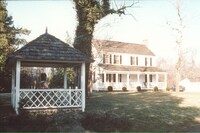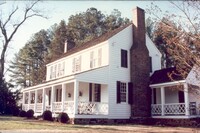Betsy Davidson died in 1845 and in 1847 William Lee Davidson II sold the property to Joseph Patterson and moved to Alabama. It is not clear if enslaved laborers were sold with the property or were taken to Alabama. Beaver Dam went out of the Davidson family for almost one hundred years until the house and 8.5 acres were purchased in 1937 by Dr. Chalmers Gaston Davidson, a collateral descendant of Betsy Davidson, and former Library Director and History professor at Davidson College. Beginning in the 1970s, Dr. Davidson restored the house, which resulted in it being listed as a Charlotte-Mecklenburg Historic Site in 1977 and placed on the National Register of Historic Places in 1979. In 1997, Davidson College acquired the property and leased it to the Town of Davidson as a public park and event space. In 2023, the college announced plans to preserve and appropriately steward Beaver Dam, using the site as a resource for educational purposes.
Beaver Dam
Beaver Dam, a plantation situated along the Davidson-Concord Road and located about two miles from campus, has long ties to Davidson College.
For many centuries, the Catawba people inhabited the land that is now known as Beaver Dam, but they were dislocated from the area as they experienced the devastating effects of war, smallpox, and other diseases introduced by European settlers. In 1754, Robert Brevard (1718-1800) received a land grant of around 800 acres at the headwaters of the Rocky River. Four years later, Charles Harris (d. 1776) purchased 600 acres of Robert Brevard’s land, noted as being “on a branch of Rocky River, including Beaver Dam.” In 1808, William Lee Davidson II (1781-1862) - the youngest son of Revolutionary War General William Lee Davidson (1746-1781) - purchased 451 acres from the Harris family and began to farm at Beaver Dam Plantation. The two-story Federal style house that currently sits on the property was built by him in 1829. The Beaver Dam plantation eventually encompassed 785 acres and included the house, a large garden, a smokehouse, a chicken house, and housing for enslaved peoples. In addition to farming, Davidson experimented with silk culture, planting mulberry trees and silk rooms and hatcheries, but the effort was abandoned in the 1840s.
William Lee Davidson II lived at Beaver Dam with his wife Elizabeth “Betsy” Lee Davidson (1782-1845) and, for some time, her father Major John Davidson (1735-1832) of Rural Hill. During their time at Beaver Dam, the Davidson family enslaved between 15 and 30 people. Unfortunately, very little about these people is documented; the U.S. Census lists only age and sex for enslaved laborers. In 1830, 21 enslaved people lived at Beaver Dam: 7 males and females under age 10, 1 male and 3 females aged 24-35, 1 male aged 36-54, and 4 males aged 100 and up. By 1840, that number had grown to 26: 3 males and 5 females under 10, 4 males and 5 females aged 10-23, 4 males and 1 female aged 24-35, 2 females aged 36-54, and 1 male and 1 female aged 55-99.
Beaver Dam played a significant role in the founding of Davidson College. At a committee meeting held at the Beaver Dam house on May 13, 1835, members of the Concord Presbytery made the decision to acquire two tracts of land totaling 469 acres from William Lee Davidson II for the site of their planned manual labor school. These tracts were not part of the Beaver Dam Plantation but were located just two miles east of it. A few months later, the committee decided to name the college for William Lee Davidson II’s father “as a tribute to the memory of that distinguished and excellent man, General William Davidson, who in the ardor of patriotism, fearlessly contending of the liberty of his country, fell (universally lamented) in the Battle of Cowan’s Ford.”
Although there was no official connection between Davidson College and Beaver Dam, students in the early days of the college would have been familiar with the plantation, since William Lee Davidson served as an original trustee and the Davidsons frequently opened their home to students. They sometimes took in Davidson College students who fell ill during the school year. An 1843 newspaper account tells of an ill student being taken to Beaver Dam “where it was hoped the refreshing atmosphere of the country, and assiduous attention of a kind family would promote his recovery.”




